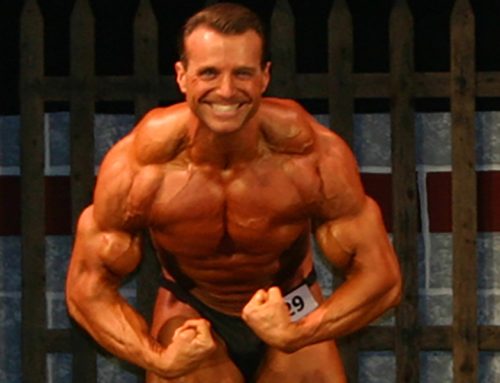Could hitting the gym twice a day boost your muscle growth, or is that only for pro bodybuilders with great genetics and unlimited time? Like most things in bodybuilding and fitness, the answer is, “It depends.” There are some huge advantages of double split training for advanced bodybuilders, and surprisingly, even for regular, busy men and women. Read on to learn about the pros and cons and whether this bodybuilding-inspired technique is right for you.

What is Double Split Training?
There are different types of double split or multi-session-a-day training systems, so let me start by defining it, so it’s clear what we’re talking about.
I’ve talked before about how some bodybuilding and fitness competitors do cardio twice a day for short periods to dial in for a contest, but double cardio is a different subject. We are not talking about cardio here.
You may have also heard about how weightlifters – notably the Bulgarians – have been known to train multiple times per day. That is also, for the most part, a different subject, and Olympic lifting or powerlifting are not my areas of expertise. I’m a bodybuilder, not a weightlifter.
What I’ll focus on in this post is the classic double split routine used by bodybuilders, where you divide your weight training workout into two sessions per day, one in the morning and one in the afternoon or evening – each session being for different body parts.
Most people will never do double split training because it requires going to the gym twice a day and that’s an inconvenience compared to getting it all done at once. But also, most people don’t need double split training because the volume and intensity of regular fitness workouts can easily get done in one session without compromise. The double split is usually used by advanced bodybuilders who are doing a lot of volume (lots of sets and exercises) with a lot of intensity.
I like double split training a lot and although I don’t use it that often, I’ve known about it since I started lifting in the 1980’s when I was a teenager. I use it on and off depending on my goals, training volume, energy level and schedule.
History of the Double Split Routine in Bodybuilding
I first heard about the double split when I read Arnold Schwarzenegger’s, Encyclopedia of Bodybuilding many years ago.
Arnold made the double split method popular, if he didn’t actually invent it. He wrote about how he would go into the gym in the morning and train one body part, or one portion of his workout for the day, and then come back later in the day or in the evening for another body part, or the second portion of his workout for the day.
Of course, Arnold was genetically elite, he had every possible advantage, he was a Mr. Olympia competitor and training was his job, literally, so he did it differently than how I’ve done it or how I would recommend it to other people. In fact, I don’t recommend what Arnold did.
Arnold was famous for training twice a day and spending hours in the gym each time. He would train two hours in the morning and two hours at night. Today, as exercise science has advanced, we know it’s not necessary to train that long every day.
So when people think of the classic double split system, if they’re having flashbacks to the 1970s and the Arnold days and thinking it means training for hours every day, that’s not what the modern proper use of double split training is all about. In fact, the opposite is true. For most people, double splitting is not about training longer, it’s about training the same amount of time and breaking it up into shorter sessions. It’s not doubling your workout time, it’s splitting your usual workout in half.
If your normal workout is 60 minutes, a double split might mean doing 30 minutes in the morning and 30 at night. If your normal workout is 90 minutes, you might do 45 minutes in the morning and 45 minutes later in the day. It doesn’t have to be split evenly either – it might mean doing 40 minutes in the morning and coming back at night for 20 minutes to do just one small body part.
Advantages of Split Routine Training
Possibly the biggest advantage is better physical energy allocation. What I mean by that is if you have a lot to do in one workout – whether that’s a lot of exercises, a lot of body parts and a lot of sets, whatever you do first in that workout, you’ll have the most physical energy for that. Whatever you do last in the workout, you’ll have the least physical energy, so the intensity and the quality of whatever comes last will be lower.
Let me give you an example: full body workouts are very popular and they’re a great choice for a lot of people – they’re good for beginners and they’re good for general fitness, conditioning or fat loss at any experience level. But for bodybuilding and muscle growth, full body training can be a disadvantage, because training your whole body thoroughly in one session is exhausting.
Suppose you do quads and hams first, you have the most energy for legs and you hit them hard and so your legs end up being well developed. And lets suppose you do arms last. You’re fatigued by the time you get to arms so you don’t hit you biceps and triceps with the same energy as you did your legs – that’s the beginning of a body getting out of balance – one body part getting a better workout than another. This is why the entire split routine system came into existence.
One day, someone asked themselves, “Why don’t I just do half my body one day and half the next?” That was the birth of the 2 day split. An example of that would be training upper body on day one and lower body plus abs on day two.
For many bodybuilders, who do a lot of exercises on each muscle group, they took it a step further with a 3 day split. An example of that is chest and back on day one, shoulders and arms on day two and legs on day three. An alternate way to do the 3 day split is day one push, day two pull, day three legs.
Some bodybuilders even go to 4 or 5 day splits. I often use a 4 day split – for example, chest and biceps on day one, shoulders and triceps on day two, back and calves and day three, legs on day four. I throw abs in anywhere, twice a week and sometimes a second calf session.
See the newest 4 day split here (4 X 4 muscle and physique)
With those types of split routines, 2 day split, 3 day split, 4 day split and so on, you’ve solved most of the energy allocation problems because you don’t have to do as much work in each session. You don’t have to train your whole body in one workout – which really would take hours if you were doing multiple sets of multiple exercises. On the split routine, your workouts are shorter and more intense. But for some people, even a body part routine isn’t split up enough and that’s when a double split comes in.
Advantages of The Double Split Routine
Here’s an example of how I’ve used a double split. I have my training set up on a 4 day split, which is designed for bodybuilding. A 4 day split only requires me to train two body parts per session – three at the most if you count abs. On the leg day, I only have to train quads and hamstrings. That’s only 2 bodyparts, so you’d figure that’s easy enough to get done in one session, and it usually is. Even if I do 3 or 4 exercises on quads and 2 or 3 on hamstrings, I can get done in an hour if I keep the rest intervals short.
But what a lot of serious bodybuilders, including myself, have found, is that if you blast the squats, and hack squats and lunges, you can be completely exhausted after those three exercises. You could go right ahead and grit your teeth and finish up with hamstrings, and most of the time, that’s exactly what we do. But what if my hamstring development is falling behind a little bit? I don’t want to compromise the quality and intensity of that hamstring workout at all.
The solution is to do quads in the morning and come back for hams late in the afternoon or in the evening, and usually I’d separate the workouts by about 8 hours or more. When I come back for hamstrings later, even though there still might be some residual fatigue from doing quads early in the day, I’ve had time to rest, refuel, rehydrate and hit that hamstring workout feeling fresh.
You’d be most likely to use a double split during focused periods where you are training with heavy weights and extremely high intensity. The difference in muscle development can be significant for someone who competes or trains seriously for high level goals.
You could test this for yourself and see the impact. Keep a training journal of the reps and weight you lift on an exercise like Romanian deadlift having done it after you’re tired from squats and other quad exercises, then try training the Romanian deadlift first in a session when you are totally fresh and compare the numbers. If you see a big difference, then you can instantly see the benefit of a double split.
Here’s a couple more examples: If you’re using the 3 day split and day one is chest and back day, you could do chest in the am and back in the pm. If you had arms and shoulders, you could do shoulders in the am and arms in the pm. Another common way that bodybuilders use double splits is they hit the big lifts in the morning and then come back at night for little muscles like abs and calves (sometimes along with cardio). Calves and abs often get blown off when they’re left to the end of a workout, so this way, they don’t get neglected because they get their own session.
There’s another advantage to double splitting and I call it mental energy allocation. Of course we know that people get physically fatigued and depleted if you do too much at once, but you also get mentally depleted. You may lose motivation toward the end of a workout and you can lose focus too. If you ask any champion bodybuilder, they can tell you about the mental energy necessary to have a great workout and that can get depleted and dispersed just like physical energy.
Intense leg workouts take an enormous mental effort. When I was at the peak of competition training, I would take days to mentally prepare for an upcoming leg workout that included intense and heavy squatting. When you pour that kind of mental energy into an exercise like squats or deadlifts, you don’t have much left for training the rest of your body. That’s why most bodybuilders don’t use full body workouts – split routines give them better mental focus.
Body part split routines have actually lost some popularity in mainstream fitness, but not in bodybuilding. Bodybuilding is very much about the mind to muscle connection. When bodybuilders go in the gym to train only one body part or one muscle group like arms, it’s intentional and they know exactly what they’re doing.
Here’s a third advantage – time allocation. This advantage is also helpful to regular people who are not bodybuilders. When someone is so busy that they have only slivers of time – 15 minutes here 30 minutes there, they can make the most of that time if they use some ingenuity in their workout planning.
Suppose you’re on the popular upper – lower two day split and day one is your entire upper body – chest, back, shoulders, biceps, triceps. There’s no law that says you have to do all those exercises in one session that takes a solid hour. You could split it up into shorter morning and night sessions.
I know stay at home moms who steal 10 or 15 minutes in the middle of the day when the baby is taking a nap, and sneak in their ab workout. I know men who are so busy with work that they swear they cant do a workout program if it takes a dedicated hour, but I’ve persuaded them that they can save time by supersetting everything and split it into 15-20 minutes early in the morning and 15-20 minutes in the evening.
This is easy for people who have equipment at home or easy access to a gym at work. If you’re willing to think out of the box and be flexible, this is a way that even people with crazy hectic schedules can get it done.
Parting Advice
There are a couple closing points I want to mention. One is that this double split technique does not reduce the effectiveness of the workout in any way whatsoever. In fact, there are some theories that two sessions a day could improve results due to hormonal response, increases in metabolism or better nutrient partitioning. But even if those potential benefits are theoretical or debatable, the improved mental and physical energy you can put into each shorter workout alone should improve results.
Second is that its not mandatory to do a double split, so I’m not suggesting everyone run out and do this unless you have a specific reason, or it’s your personal preference. For most people, two trips to the gym is not practical, especially for someone who has to travel to the gym, compared to someone who works out at home.
If you want to see what complete double split training schedules look like, we’ll have to save that for another blog post. You can simply consider this an introduction to the double split method. But with this brief primer, you now have enough info that you can already go ahead and put this to use if it suits your goals and sounds like something you want to try.
Train hard and expect success!
Tom Venuto,
Founder and CEO, Burn the Fat Inner Circle
PS. Follow on Instagram: www.instagram.com/tomvenuto/

Tom Venuto is a natural bodybuilding and fat loss expert. He is also a recipe creator specializing in fat-burning, muscle-building cooking. Tom is a former competitive bodybuilder and today works as a full-time fitness coach, writer, blogger, and author. In his spare time, he is an avid outdoor enthusiast and backpacker. His book, Burn The Fat, Feed The Muscle is an international bestseller, first as an ebook and now as a hardcover and audiobook. The Body Fat Solution, Tom’s book about emotional eating and long-term weight maintenance, was an Oprah Magazine and Men’s Fitness Magazine pick. Tom is also the founder of Burn The Fat Inner Circle – a fitness support community with over 52,000 members worldwide since 2006. Click here for membership details







Leave A Comment